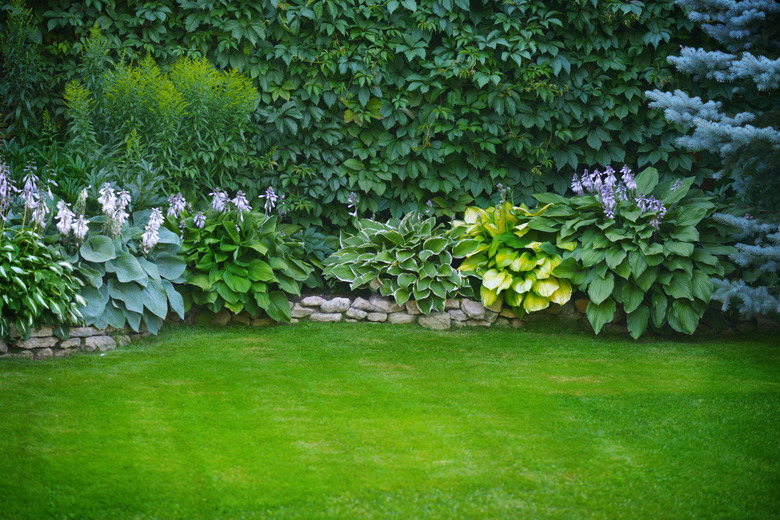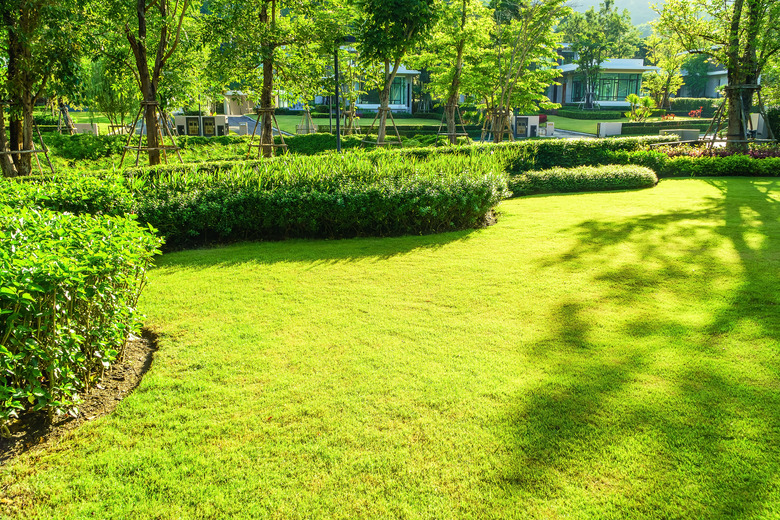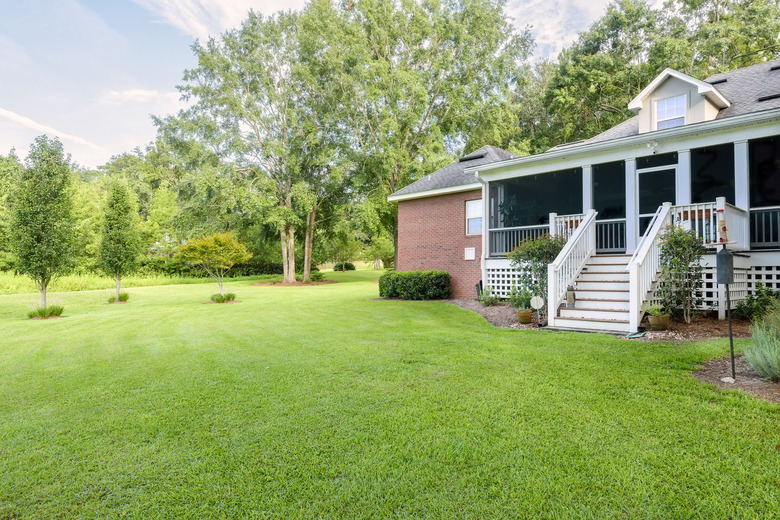10 Best Weed Killers For All Your Lawn Problems
A pristine, emerald-green sweep of lawn in the front yard is every homeowner's dream, and sometimes, their nightmare is weeds that disturb this vision. What are the best weed killers for lawns to maintain the emerald green and get rid of weeds without damaging the lawn? Science has devised many types of weed killers for lawn care.
How to Assess Lawn Problems
How to Assess Lawn Problems
How do you decide on the best weed killers for lawns? First, know your enemy. Analyze your types of weeds and decide on a plan for your best lawn. Do you have a seasonal problem with dandelions (Taraxacum officinale, USDA zones 3-10), a battle with annual crabgrass (Digitaria spp.) or an ongoing fight against ground ivy, aka bindweed (Convolvulus and Calystegia spp., USDA zones 3-9)?
Next, determine what caused the weeds. Too much shade is a common culprit. Four hours of sun is the minimum requirement for a decent lawn of cool-season turfgrasses, such as fescue and bluegrass. A minimum of six hours of sun is necessary to provide a decent stand of Bermuda or St. Augustine, which are warm-season turfgrasses, and more sun is always better. A lack of sunlight weakens the lawn, making it easier for weeds to take hold and thrive. To get the sunlight you need, remove lower branches from shade trees to get more sun on the lawn.
If a complete overhaul is in order, you might need a complete renovation. If enough of the lawn is salvageable, consider a partial renovation with overseeding after removal of the existing weeds.
Considerations When Using Weed Killer/Herbicides
Considerations When Using Weed Killer/Herbicides
Many weed killer products are toxic, so always read the labels. Focus on when to apply the products and the appropriate outside temperature. Be sure the type of weed killer is compatible with your lifestyle and your lawn. Some products are so toxic that they may not be compatible for homes with children and pets.
Also, always check products for drying times and keep everyone off the lawn until the product is dry and safe for walking on. Many products are not rainproof for a period after they dry, so pay attention to the weather before your application. It's also crucial to make sure the type of lawn you have is compatible with the type of herbicide you are planning on applying, as certain types of turfgrasses are susceptible to damage from weed killers.
Bear in mind that what is applied to the lawn also potentially goes into the water table, so use the minimum amount of herbicide possible. Follow the mixing methods and application rates specified on the label and wear protective clothing. Don rubber gloves, protective goggles, long pants and shoes before applying herbicides.
What Is a Weed?
What Is a Weed?
A weed is nothing more than an unwanted plant. Most homeowners want a lawn composed primarily of turfgrasses, such as Bermudagrass (Cynodon dactylon, USDA zones 7-10) or fescue (Festuca spp., USDA zones 3-7). The rest of the green stuff coming up in the lawn can be considered weeds. Weed types vary by area of the country and are usually cool-season or warm-season weeds. The cool-season weeds sprout when soil temperatures cool for winter, and the warm-season weeds sprout when soil temperatures rise in spring.
The types of weeds commonly found in lawns include broadleaf weeds and grassy weeds. Broadleaf weeds are things like dandelions, chickweed (primarily Stellaria and Cerastium spp., USDA zones 3-11), ground ivy, thistles (Cirsium spp., USDA zones 3-9) and oxalis (Oxalis spp., USDA zones 3-11, depending on species). Grassy weeds are some of the most difficult to control and include nut sedge (Cyperus spp., USDA zones 3-10, depending on species), crabgrass and Johnsongrass (Sorghum halapense, USDA zones 7-10).
Lawn weeds can be annual or perennial. Annual weeds grow from a seed and live for one season, flowering and producing more seeds to continue the cycle. (Some crabgrass species can produce an astounding 150,000 seeds in one season.) Other annual weeds include chickweed and yellow oxalis. Perennial weeds stay in place year after year and can grow from root systems and cuttings and produce seeds. Common types of perennial weeds include dandelions and ground ivy, aka bindweed.
Types of Weed Killer/Herbicide
Types of Weed Killer/Herbicide
Before purchasing products to tackle the weeds in your lawn, it's helpful to know a glossary of terms that will assist you in choosing the right tools for your lawn's individual needs.
- Pre-emergent herbicides prevent weed seeds from sprouting.
- Post-emergent herbicides kill existing weeds.
- Selective herbicides kill specific targeted weeds without killing the surrounding grass.
- Nonselective herbicides kill everything that is green.
- Translocating herbicides move through plant tissues and kill more effectively than non-translocating formulas.
References
1. Pre-emergent Herbicides
Weed preventers are pre-emergent herbicides that prevent the growth of new weeds by forming a chemical barrier over the soil to prevent seeds from sprouting. Ideally, pre-emergent herbicide is applied to the lawn before soil temperatures are conducive to weed growth. To prevent both cool-season and warm-season weeds, these products are usually applied in early spring and fall. The dates to apply pre-emergent herbicides vary by USDA hardiness zone. Contact your local cooperative extension service for further information on dates for your region.
These products prevent weeds from sprouting but can also affect germinating lawn grass seed and bulbs in early spring. Application must be arranged around the seeding of the lawn. Timing varies by product, so check the label. They may be applied as a granular product with a spreader or in liquid form when mixed in a sprayer. Preen has a granular product for lawns, and one is available for flower beds as well.
2. A Combination of Pre- and Post-Emergent Herbicides
Combining pre- and post-emergent herbicides will kill both weed seeds and certain weeds that are actively growing, perfect for the homeowner who may have missed that early spring or fall deadline to prevent the weed growth in the first place. Weeds susceptible to these herbicides include grassy and broadleaf weeds, such as crabgrass and dandelions. However, be aware that herbicide has the odd effect of turning some weeds white as they are dying.
These products take about three weeks to kill actively growing weeds and may require an additional application to achieve control, but the residual control of weeds is long-lasting. Take note, however, that these products may not be used on actively growing Bermuda or St. Augustine lawns.
3. Weed and Feed
Weed and feed products are pre- and/or post-emergent herbicides with fertilizer included in the mixture to be applied generally twice a year to take care of summer and winter weeds. This is probably the easiest product to use on a home lawn, but it is the least effective in controlling stubborn weeds. Read the label to ensure the product is effective for the specific weeds in your lawn.
These products are available in a liquid that may be applied with a sprayer, and there are granular products that are applied with a spreader. Spectracide makes a weed killer with fertilizer, called Weed and Feed, that covers up to 7,500 square feet when applied with a garden hose.
4. Selective Broad-Spectrum Herbicides
Selective herbicides are the next tools in the weed-killer arsenal. They kill the weeds in the existing lawn without killing the lawn. Ortho Weed B Gon is a fast-acting, broad-spectrum herbicide that kills many types of grassy and broadleaf weeds. For best results, apply this type of weed killer directly onto weeds rather than spraying the entire lawn. Direct application reduces the amount of toxic chemicals on the lawn, and it ensures the weed killer reaches the weeds. This makes it more effective overall than broadcast weed and feed products. Be aware that two applications (spread about two weeks apart) per season often are required.
Do not use broad-spectrum herbicides on bent grass, carpet grass, Floratam St. Augustine, seashore pasplanum or dichondra. Care should be used when applying selective herbicides to St. Augustine lawns since they are very susceptible to damage from any herbicide. These herbicides should only be used on established lawns, as newly seeded lawns will be damaged.
5. Selective Post-emergent Herbicides
These herbicides get rid of specific stubborn weeds, such as nutsedge and crabgrass. The product is usually in liquid form that is applied with a sprayer to problem areas. Image, for example, is used for weed control of nutsedge, and Scotts Halts Crabgrass Preventer targets crabgrass. (Although it should be noted that mature crabgrass can be difficult to control with any type of herbicide.)
Though these weed killers are similar to selective broad-spectrum herbicides in that they kill weeds and not the surrounding grass, they are designed for use on lawns that need help with specific (and often stubborn) types of weeds. Read the labels to determine compatibility with certain lawn types. St. Augustine in particular can be affected by selective weed killers.
6. Nonselective Herbicides That Translocate
Nonselective herbicides simply kill everything they touch, including lawn grass. So, it goes without saying that you should be careful where the sprayer is aimed when applying these herbicides. Do not use these products on grassy areas unless you want to kill the surrounding grass. These weed killers are typically applied to dry foliage when temperatures are above 45 and less than 90 degrees Fahrenheit. They probably won't kill woody vegetation but may damage it severely.
These nonselective herbicides trigger a process called translocation, which occurs when the killing agents in the herbicide are absorbed through the leaves of the plants and transmitted through the plants' circulatory system down to the roots. These are the most effective, fast-acting weed killers. They are rainproof once dry and take up to a week to kill existing weeds.
Glyphosate, a component in Roundup, is a commonly used active ingredient in nonselective herbicides. Glyphosate has been in use for decades, and weeds are actually becoming resistant to it. Roundup and glyphosate, however, have recently sparked a great deal of controversy regarding their safety for use in the garden as they have been reported to be carcinogenic.
7. Nonselective Herbicides That Do Not Translocate
Acetic acid (vinegar) weed killers are available for those who want to use a less toxic product. However, these herbicides do not translocate through plants and are less effective at killing weeds. They may require more than one application to achieve weed control.
Generally, these products are not made with household vinegar but with horticultural vinegar, which is many times stronger and can potentially burn skin and eyes. They should not be handled without eye protection and rubber gloves. They generally burn the tops of the plants and must be applied when the plants are dry and in the sun for best results. Best results with these types of herbicides are killing weeds in cracks in paving in the sun where the product soaks in and gets down to the roots.
8. Natural and Organic Herbicides
There are many new organic and natural weed killer products on the market whose ingredients may include seawater, citric acid and essential oils. They are nonselective and usually do not translocate but may provide visible results in one hour and are rainproof after they are dry. A small bonus is that they usually smell good as well, with clove oil being a common component of these products. Organic products are not necessarily nontoxic, and care should be used in allowing areas to dry before children and pets are allowed on treated areas, but the efficacy varies with different products.
9. Nontoxic Herbicides
Nontoxic weed killers and pre-emergent products are becoming more popular as homeowners and gardeners are trying to be more environmentally and safety conscious. When a product is labeled nontoxic, it means the ingredients of the product are not regulated by the Environmental Protection Agency. These products are safer than some of the products made with regulated chemicals, but they still cannot be ingested so it's still a good idea to lock them away from curious children or pets. Usually, the area where the product has been used may be re-entered shortly after the product has been applied.
Corn gluten meal may be used as a pre-emergent herbicide in lawns, flower beds and vegetable gardens. It also provides a small amount of nitrogen for fertilizer and may be applied in granular form. Preen makes a corn gluten pre-emergent. Corn gluten is a byproduct of corn processing.
Ecomight is a nontoxic weed killer that translocates. It is nonselective and works on grassy and broadleaf weeds with active ingredients that include peppermint oil and potassium sorbate.
10. DIY Weed Herbicides
Recipes abound on the internet for homemade weed killers. Some homeowners swear by them as the best weed killers and feel more comfortable mixing and applying active ingredients such as vinegar, salt, dish soap and various essential oils. Most of these recipes, however, do not have the support of research and, in many cases, may do more harm than good.
The most common recipe includes white vinegar, dish soap and rubbing alcohol or salt. Dish soap makes the mixture stick to foliage, vinegar burns it and salt or rubbing alcohol dehydrates the plant. This is mixed in a sprayer and applied in full sun. Be aware that these mixtures usually take more than one application to kill weeds, and some stubborn weeds may not be affected by homemade weed killer. Also, most homemade formulas are nonselective and will likely damage grass and other plants along with the weeds.



